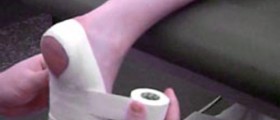
Heel spur is a medical condition which affects heels. It features with a bony outgrowth which protrudes from the heel bone. This bony outgrowth causes severe and very intensive pain and irritation/inflammation of the nearby tissue.
The heel bone is the largest bone in the foot and it effectively absorbs pressure and shock exerted on the foot. This bone is connected with the forefoot with a thick connective tissue medically known as the plantar fascia. The basic role of the plantar fascia is to maintain the arch of the heel. The bony protrusions may originate from calcium deposits of the plantar fascia. Bony outgrowths resemble a nail and they form around the tendons of the foot. They are attached to the heel bone, protrude from the heel bone and grow directly into the soft tissue of the foot. The affected tissues are irritated and inflamed and this represent a source of excruciating pain of heel spurs.
Heel Spurs Symptoms
As it has already been mentioned the most prominent symptom of heel spurs is the intensive pain. The affected area is inflamed and tender. There is an obvious restriction in foot's mobility. Reduced mobility of the foot is not caused by structural changes (even though they are responsible for the pain), but it occurs due to pain. Namely, the pain alleviates if the foot is immobilized and not used.
The pain in heel spurs initially affects the bottom of the foot and eventually starts to radiate towards the arch of the foot. It is most intensive in the morning (when a patient wakes up), during standing or walking (especially after a period of rest) and activities such as jumping. The pain may subside as a patient continues to walk.
Heel Spur Treatment
Heel spur can be easily seen on X-ray of the affected foot. The bony outgrowths are perfectly visualized.
The pain caused by heel spurs can be alleviated conservatively or surgically. The inflammation of the soft tissues around the heel spur is brought under control with rest and staying away from any activity which can cause further irritation and inflammation. Furthermore, ice pack application is beneficial for reduction of both, inflammation and pain. The relief is, unfortunately, temporary and the pain returns.
People suffering from heel spurs can also benefit from shoe inserts and night splints. Long-term control of the pain caused by heel spurs can be achieved with anti-inflammatory medications. However, even medications are not permanent solution. The only way to completely get rid of heel spurs is to undergo surgical procedure. Surgery for heel spurs is indicated in case all the conservative treatment fails.

















Your thoughts on this
Loading...